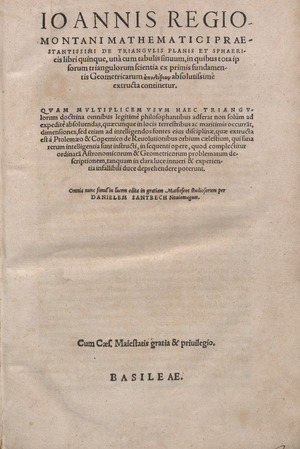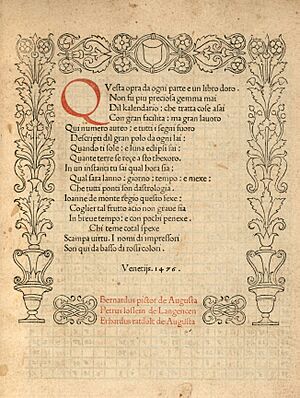Regiomontanus facts for kids
Quick facts for kids
Regiomontanus
|
|
|---|---|

18th-century portrait (Iohannes de Regio Monte dictus alias Müllerus)
|
|
| Born | 6 June 1436 Königsberg, Electorate of Saxony, Holy Roman Empire
|
| Died | 6 July 1476 (aged 40) |
| Nationality | German |
| Education |
|
| Known for |
|
| Scientific career | |
| Fields | Mathematics (trigonometry), astronomy, astrology |
| Institutions | Universitas Istropolitana |
| Academic advisors | |
| Notable students | Domenico Novara da Ferrara |
Johannes Müller von Königsberg (born June 6, 1436 – died July 6, 1476), also known as Regiomontanus, was a very important mathematician and astronomer during the German Renaissance. He worked in cities like Vienna, Buda, and Nuremberg. His ideas helped a lot with the development of the idea that the Earth goes around the Sun after he died.
Regiomontanus wrote under a Latin name, Ioannes de Monteregio. The name Regiomontanus was first used later, in 1534. He is named after his hometown, Königsberg in Germany, not the larger city of Königsberg (which is now Kaliningrad).
Contents
His Life and Studies
We don't know much about Regiomontanus's early life. But it is thought that he started studying at the University of Leipzig when he was only eleven years old. In 1451, he moved to the University of Vienna in Austria to continue his studies.
In Vienna, he became a student and friend of Georg von Peuerbach, who was also a famous astronomer. Regiomontanus earned his first degree (a bachelor's) in 1452. He then got his master's degree in 1457, when he was 21. He also taught classes on optics (the study of light) and old literature.
A Promise to a Friend
In 1460, a special visitor named Basilios Bessarion came to Vienna. He was a diplomat from the Pope and loved science and math. Bessarion became friends with Peuerbach. Bessarion wanted a better Latin translation of an important astronomy book called Almagest by Ptolemy. Peuerbach started working on a shorter, improved version of the book.
Bessarion invited Peuerbach to come with him to Italy. Peuerbach agreed, but only if Regiomontanus could come too. Sadly, Peuerbach got sick in 1461 and died. He had only finished part of the book. On his deathbed, Peuerbach made Regiomontanus promise to finish and publish the book.
Travels and New Discoveries
In 1461, Regiomontanus left Vienna with Bessarion. For the next four years, he traveled around Northern Italy. He helped Bessarion find and copy old math and astronomy books. Bessarion had one of the biggest private libraries in Europe at that time. Regiomontanus also met important Italian mathematicians like Giovanni Bianchini and Paolo dal Pozzo Toscanelli.
In 1467, Regiomontanus started working for János Vitéz, an archbishop in Hungary. There, he created many detailed astronomy tables and built special tools for observing the stars. He then went to Buda, where he worked for King Matthias Corvinus. He built an astrolabe for the king and helped collect old Greek books. While in Hungary, he also created important trigonometric tables for astrology.
The First Scientific Printing Press
In 1471, Regiomontanus moved to Nuremberg, a busy city known for learning and trade. Here, he worked with a merchant named Bernhard Walther. Together, they started the world's first scientific printing press!
In 1472, Regiomontanus published the first printed astronomy textbook. It was called Theoricae novae Planetarum and was written by his old teacher, Georg von Peuerbach.
Regiomontanus and Bernhard Walther also observed the comet of 1472. Regiomontanus tried to figure out how far away it was from Earth. He was one of the first to try and measure the physical size of a comet, even though his measurements were not exact. The comet was seen from Christmas Day 1471 until March 1, 1472.
Later Life and Death
In 1475, Pope Sixtus IV asked Regiomontanus to come to Rome. The Pope wanted his help to fix the calendar. The Pope promised him great rewards, possibly even making him a bishop.
On his way to Rome, he stopped in Venice. There, he arranged for his book Calendarium to be printed. Regiomontanus reached Rome, but he died only a few months later, on July 6, 1476. He was only 40 years old. Some people rumored he was poisoned, but it's more likely he died from the plague.
His Important Work
While in Italy, Regiomontanus finished Peuerbach's shorter version of the Almagest, called Epytoma in almagesti Ptolemei. In 1464, he finished his own book, De triangulis omnimodis ("On Triangles of All Kinds"). This was one of the first textbooks to explain everything known about trigonometry at the time. It even had questions for students to review!
He wrote in his book:
You who wish to study great and wonderful things, who wonder about the movement of the stars, must read these theorems about triangles. Knowing these ideas will open the door to all of astronomy and to certain geometric problems.
His work on arithmetic and algebra, called Algorithmus Demonstratus, was one of the first to use symbolic algebra, which uses letters and symbols in math. In 1465, he built a small, portable sundial for Pope Paul II.
In his book Epytoma in almagesti Ptolemei, he pointed out mistakes in an earlier translation of the Almagest. Later, Nicolaus Copernicus said that this book influenced his own famous work.
Regiomontanus was a very productive writer and was famous around the world during his lifetime. Even though he only finished about a quarter of what he planned to write, he left behind many important works. Nicolaus Copernicus's teacher, Domenico Maria Novara da Ferrara, said that Regiomontanus had been his own teacher. Some people think Regiomontanus might have believed in the heliocentric theory (that the Earth moves around the Sun) before he died. He paid special attention to the ideas of Aristarchus, who also thought the Earth moved.
His Legacy
Regiomontanus's work continued to be important after his death. Simon Stevin, a mathematician, used Regiomontanus's ideas about trigonometric tables when he described decimal numbers.
Regiomontanus also created his own system for astrological houses, which became very popular in Europe.
In 1561, a collection of Regiomontanus's works was put together by Daniel Santbech. It included his book De triangulis planis et sphaericis libri quinque and other writings.
There is a picture of Regiomontanus in the 1493 book Nuremberg Chronicle. In the picture, he is holding an astrolabe.
Today, a crater on the Moon is named after him to honor his contributions to astronomy.
Images for kids
See also
- List of unsolved deaths
- Regiomontanus' angle maximization problem
- In Spanish: Johann Müller Regiomontano para niños






